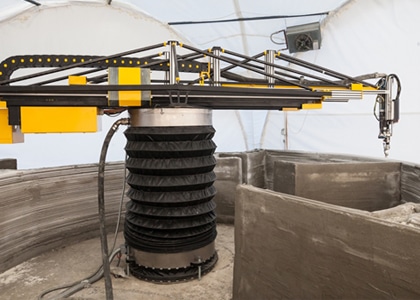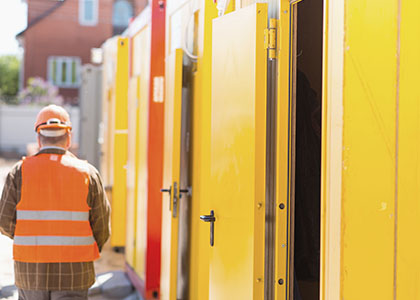Home / Blog / Is it the Right Time for Your Construction Business to Embrace Digitalization? 4 Pros and Cons of Digitalization in Construction
Summary
Whilst other industries are undertaking aggressive systemic overhauls for more digitalization, the construction industry is still using traditional methodologies and processes. There are many justifiable reasons for this; the industry is vast and requires coordination between many parts, processes, and people with different proficiency levels.
Project planning, for example, is often uncoordinated between the office and the field and is often done on paper. Additionally, construction contracts do not usually include incentives for risk-sharing and innovation. Also, performance management is inadequate, and supply-chain practices are still unsophisticated. And still, the industry has not yet embraced new digital technologies that need up-front investment, even if the long-term benefits are significant.
However, the fact remains that the push toward digitalization is accelerating. Even if construction industry players are confused and hesitant, they have to face up to a changing reality. Incorporating digital strategies can offer innumerable opportunities for cost efficiency and on-site coordination. Additionally, new digital technologies, like building information models (BIM) and augmented reality, can improve client experience and project visualization.
This article highlights the digital technologies available to the industry to help you stay updated, competitive, and relevant.
INDEX
DIGITAL DRIVERS CHANGING THE CONSTRUCTION INDUSTRY
4 ADVANTAGES OF DIGITALIZING CONSTRUCTION
4 CHALLENGES TO DIGITALIZING CONSTRUCTION
IS DIGITALIZATION THE FUTURE?
Is it the Right Time for Your Construction Business to Embrace Digitalization?
4 Pros and Cons of Digitalization in Construction
Compared to other industries that have been quicker to digitalize, the construction industry is ripe for technological disruption. According to a 2016 report by McKinsey, construction projects (especially large ones) take 20% longer to finish and are up to 80% over budget. This holds true even today.
By incorporating digitalization processes across construction, businesses can create efficiency in operations, facilitate effectiveness, and find new opportunities for growth.
Here are a few things you need to consider.

DIGITAL DRIVERS CHANGING THE CONSTRUCTION INDUSTRY
Whilst digitalization has the potential to help your construction business, the truth is that there isn’t a single best way to go about it. Digitalization can reduce overheads and introduce dynamic changes in a business’s agility, performance, and coordination; however, determining what processes to implement depends on your specific needs and goals.
We list some digital tools below to familiarize you with some options used across the construction sector.
-
Building Information Modeling (BIM)
BIM is a digital process that allows you to see a simulation of a project even before a single brick has been laid. A method of virtual design and construction, BIM charts a project’s lifecycle and can help with mitigation and planning errors.
It also allows for faster calculations, quantifies extra costs, and maps all the viable options available to execute a piece of work. Additionally, with BIM, you can make models that have several dimensions of project information, including:
- 3D BIM, which can be used to assess the constructability of a building before the project is executed.
- 4D BIM, which enables visualization of the building model over time by simulating the construction process.
- 5D BIM, which assists with early budget estimations, incorporating higher levels of detail and accuracy.

-
Virtual, Augmented, and Mixed Reality
The introduction of augmented reality (AR), virtual reality (VR) and mixed reality (MR) has brought a huge shift to the way construction companies consume and interact with data. Walking through a property with the assistance of VR headgear can provide you and your clients an immersive look into what the project could look like upon completion.
While VR is useful during the pre-construction stage, AR comes into play once the project has begun. With a smartphone or tablet, technical documentation or 3D models are merged onto real-time images of the project as it stands on a site to offer clients a current a future view of the project.
-
Mobile Technology
Mobile technology is utilized across almost all industries because it offers a particularly effective method of making workflows more efficient.
Within the construction industry, mobile technology has made processes faster and more efficient, including rapidly transferring data, managing files and drawings, more accurate calculations on-site, expense tracking, swifter reporting, and capturing labor and equipment hours. It also plays a role in sustainability by helping the industry reduce its paper usage.
-
Internet of Things (IoT) and Smart Sensors
As IoT devices can communicate with each other much faster than traditional methods, they can connect your construction site, turning it into a web of trackable devices that are easily accessible and controlled from a single office.
For example, IoT devices and smart sensors are increasingly used on construction sites for worker-safety, cost reduction, quality assessment, and energy efficiency. These devices can help maintain the life and longevity of items by, among other uses, forecasting environmental conditions.
IoT devices with sensors can also connect with other machines over the internet for better communication with trucks, bulldozers, and haulers, etc., as well as wearable technology like Fitbits and smart safety goggles.

-
Drones
Drones and unmanned aerial vehicles are moving from the commercial market to the construction industry and have the potential to offer your business innumerable benefits.
You can use them for aerial surveys, inspections, health and safety inductions. What’s more, they can help with visual progress reports, promotional photography, laser scanning, and thermal image recordings. Drones have also bridged the communication gap between offices and sites and assist with accurate and precise large-scale site measurements.

-
AI and Machine Learning
AI uses smart algorithms to translate bulk data, forecast risks, monitor and maintain equipment, and analyze the best choices to avoid constructional hazards. By learning through repeat use, AI can quickly review large datasets for past experiences to find patterns, which would otherwise be a herculean task for humans.
4 ADVANTAGES OF DIGITALIZING CONSTRUCTION
Large construction projects are incredibly complex and require advanced synchronization of people, equipment, and materials – all the way from planning to on-site execution. Moving from paper-based processes to digital solutions can help address many of the typical pain points you may be experiencing.
From managing the supply chain to tracking crew productivity, digital solutions provide real-time information, transparency, timely analytics on progress, risks, and enhanced coordination between all the moving parts of your organization, allowing you better end-to-end management.
Listed below are some of the advantages of implementing digitalization across construction.

-
Cost-saving Survey Technologies
Unexpected geological issues are one of the major reasons that projects are delayed and go over budget. Discrepancies between ground conditions and early survey estimates can require costly last-minute changes to project scope and design.
New techniques that integrate high-definition photography, 3D laser scanning, and geographic information systems, enabled by recent improvements in drone and unmanned-aerial-vehicle technology, can dramatically improve the accuracy and speed of your project.
Modern survey technologies, like Lidar and real-time kinematic GPS, offer high-resolution cameras that are small and light enough to be mounted on standard industrial drones. These devices are a faster and cheaper alternative to helicopter-mounted cameras for aerial surveys. Incorporating specialized technologies like these gives you both cost-efficiency and quicker processing.
-
Building Information Modeling
BIM should be considered the backbone of digitalization for construction projects. It is a digital strategy that combines and connects the data from various software, drones, construction engines, and infrastructure equipment.
BIM, especially 5D-integrated planning, when paired with smart budgeting, can significantly reduce costs and delays while improving quality, security, and visibility along the full construction value chain.
Implementation, of course, will vary from one construction company to another, depending on your position in the value chain. For example, promoters, contractors, equipment manufacturers, or facility management operators will consider BIM differently.
Similarly, contractors, building, and infrastructure players apply BIM differently. General contractors may benefit more from higher-efficiency engineering, better-managed project lead times, and reduced waste, whereas, building material suppliers may see more efficient management across volumes and inventories.

-
Digital Collaboration and Mobility
One reason for the industry’s poor productivity record is that it still relies mainly on paper to manage its processes and deliverables, including blueprints, design drawings, procurement, supply-chain orders, equipment logs, daily progress reports, and punch lists.
Digitalizing workflows can substantially benefit your construction enterprise by moving towards online, real-time sharing of information. This ensures improved transparency and collaboration, timely progress, risk assessments, and quality control.
Equally, keeping an eye on new construction tends, like prefabrication, modular production, self-healing concrete, aerogels, nanomaterials, and 3D printing, among others, can further streamline digital collaborations and increase your productivity.
-
IoT and Technologically Advanced Design Processes
Nowadays, project sites have a seemingly endless increase in personnel and laborers, construction equipment, and the amount of work under process at one time. Each site generates vast amounts of data, a majority of which is not even captured, let alone measured and processed.
IoT is fast becoming a reality in many other sectors, where sensors and wireless technologies enable equipment and assets to connect and communicate with each other. Incorporating IoT in construction allows you to capture and review critical performance parameters. Sensors, near-field communication devices, and other technologies can help monitor the productivity and reliability of both staff and assets.
4 CHALLENGES TO DIGITALIZING CONSTRUCTION
The traditional structure of the industry is one of the biggest challenges to incorporating digital transformation. One major obstacle is the perception that the intricacies involved in construction projects may be jeopardized by adopting anything new at all. Another reason for resistance is a shortage of large players who can set industry-wide standards.
Here are some of the most common challenges you may face if you want to implement wide-scale digitalization across your business.
-
Lack of Standardization and Information
A lack of standardization across the construction industry makes it difficult to implement change. There is not enough existing industrial data regarding the implementation of universal digitalization, and further studies are impeded as construction sites are busy and dynamic project environments, with large numbers of personnel and equipment operating under tight deadlines.
This is made more difficult where projects can be privatized on a geographic basis, making information scarce for business owners like you. Achieving greater collaboration and seamless data flow across large sites becomes difficult without support infrastructure like internet coverage, etc.

-
Lack of Competent Staff
Whilst technological innovations have generated significant interest in the construction and digital engineering world, they still need to be adopted by the right professionals to achieve substantial results.
Finding a competent team that can manage new technologies requires specialized expertise and constant training. This can be an expensive investment for construction companies, especially smaller ones.
-
Cultural and Technical Resistance to Change
Whilst the biggest benefit of digital transformation is that it reduces human error, it does prioritize software over people, which can create resistance from personnel. As a business owner, you may face both cultural and technical resistance to change. That’s because digitalization can potentially make redundant a wide spectrum of people who cannot adapt or lack the skills to do so.
Additionally, even with internet access increasing across the world, sites are open spaces and generally do not have universal internet coverage. In locations where internet access is limited, data entry is difficult.

-
Return on Investment (ROI)
Investment in digital technologies, like reality mesh and digital engineering, is an expensive undertaking. This limits their adoption as companies need to justify ROI.
Whilst there are success stories in the developed world where these technologies have made an impact, there are very few examples coming from developing countries. The challenge for business owners like yourself lies in not only making these technologies cost-effective but efficiently educating staff on their use.
IS DIGITALIZATION THE FUTURE?
Whilst the construction industry has been slower than others to embrace digitalization, the fact is it’s quickly becoming an unescapable game-changer revolutionizing almost every industry. With the use of smart devices and IoT on the rise across other sectors, it is only a matter of time before consumers demand more from construction businesses as well.
But, do you really need it?
It is undeniable that digitalization allows for greater collaboration and information management. With new technologies redefining engineering practices, as well as what we expect from any project, it makes sense for construction businesses to incorporate some digital processes to evolve, compete and survive in the industry.
Digital technologies like BIM, virtual reality, drones, 3D mapping, 3D printing, and mobile technology are transforming construction and can help companies like yours offer competitive options to clients. Now is the time to consider whether adopting certain digitalization technologies is right for your business’s future.
For information on construction-related digital processes, or to find out how Binex can help support you with digitalization across your projects, get in touch here.











